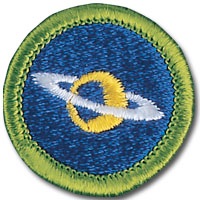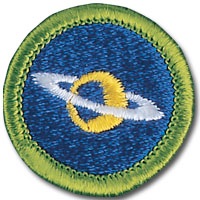Astronomy Merit Badge






Astronomy Merit Badge Supplementals
(updated Fri. Nov. 29, 2019)
The Astronomy merit badge requirements are listed at:
http://meritbadge.org/wiki/index.php/Astronomy,

which shares:
“In learning about astronomy, Scouts study how
activities in space affect our own planet and bear
witness to the wonders of the night sky: the nebulae, or giant clouds of gas and dust where new stars are born; old stars dying and exploding; meteor showers and shooting stars; the moon, plants and a dazzling array of stars.”

Astronomy, the two-part definition:
Astro
Definition of ASTR-
: star : heavens : outer space : astronomical <astrophysics>
source: http://www.merriam-webster.com/dictionary/astro
-nomy
Definition of -NOMY
: system of laws governing or sum of knowledge regarding a (specified) field <agronomy>
Origin of -NOMY
Greek -nomia, from nomos
source: http://www.merriam-webster.com/dictionary/-nomy

MeritBadge.org’s Astronomy page also contains an Astronomy Merit Badge worksheet to write your answers to the requirements.
Scouting.org’s Merit Badge page also includes digital copies of the requirements from the paper merit badge books.
The Astronomy requirements are available at: Astronomy [Merit Badge Book] - Current.

The purposes of this page are to
-
1)list the Astronomy merit badge requirements
and
-
2)provide information about the answers beyond those provided in the Merit Badge book; please know that only those answers in the book are required to complete the merit badge. The information on these pages should provide a deeper understanding of the points made in the Astronomy Merit Badge book.
Astronomy requirements are listed on these pages in bolded dark green text.

Merit Badge Requirement
4. Do the following:
-
(a)Identify in the sky at least 10 constellations, at least four of which are in the zodiac.
-
(b)Identify in the sky at least eight conspicuous stars, five of which are of magnitude 1 or brighter.
-
(c)Make two sketches of the Big Dipper. In one sketch, show the Big Dipper’s orientation in the early evening sky. In another sketch, show its position several hours later. In both sketches, show the North Star and the horizon. Record the date and time each sketch was made.
-
(d)Explain what we see when we look at the Milky Way.
Most of the information for this requirement can be found in the Merit Badge book, on pages 12-25.

-
4.Do the following:
-
(a)Identify in the sky at least 10 constellations, at least four of which are in the zodiac.
The constellations are maps of the sky, defining boundaries so we have reference points to that which we see and study.
There are 88 official constellations in the sky, some in the northern sky and some in the southern sky.
To identify at least four constellations that are in the Zodiac, it is helpful to know what the zodiac is.
The sun, the moon, and the planets move through though the sky through a certain path, which is called the ecliptic. The ecliptic is sort of like an “equator” in the sky, as northern constellations are “above” the ecliptic and the southern constellations are “below” the ecliptic.
The constellations in the sky that the ecliptic passes through are called the zodiac constellations.
Three are officially twelve zodiac constellations, though there is a thirteenth constellation - Ophiuchus, that the ecliptic passes through.
Your Merit Badge books lists the zodiac constellations. You can also see some images of the constellations, and their relative positions in the sky, on this website:
https://earthsky.org/space/what-is-the-ecliptic
https://earthsky.org/astronomy-essentials/what-is-the-zodiac
Astronomy Magazine provides this diagram of the time the sun spends in each zodiac constellation in its November, 2013 issue:
(and there is no correlation between these constellations, the time the sun spends in them, and the astrological perspectives shared through newspapers and websites)
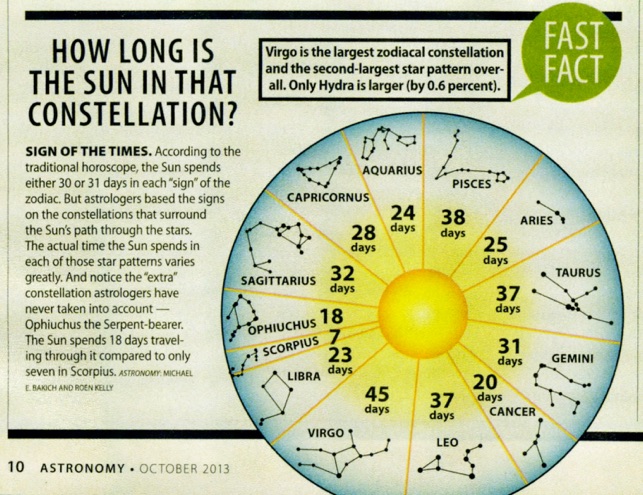

4. Do the following:
-
(b)Identify in the sky at least eight conspicuous stars, five of which are of magnitude 1 or brighter.
Your Merit Badge book has a table of the brightest stars on page 22.

4. Do the following:
-
(c)Make two sketches of the Big Dipper. In one sketch, show the Big Dipper’s orientation in the early evening sky. In another sketch, show its position several hours later. In both sketches, show the North Star and the horizon. Record the date and time each sketch was made.
This activity is one you need to complete by looking at the sky and drawing. Your artistic skills are not being judged... just draw the sky as best you can and show which way the Big Dipper rotates through the night (hint... think in terms of it rotating clockwise or counterclockwise).
One of our 2014 STEM U Scouts mentioned that the Big Dipper is an asterism in Ursa Major.
Ursa Major is the name of the constellation, “the Big Bear.”
An asterism is a small group of stars, often in a larger constellation, that has its own shape.
The Big Dipper looks like a large ladle, within the large bear.
Others see a plow, which is a different shape of the same stars making that asterism.
Another asterism is the teapot in Sagittarius, the archer.
Can you see the teapot in this image: http://cs.astronomy.com/asy/m/starclusters/489200.aspx ? (hint, look toward the lower-center to the lower-right).
See also https://en.wikipedia.org/wiki/Sagittarius_(constellation).
The northern cross is an asterism in Cygnus, the swam: http://cs.astronomy.com/asy/m/starclusters/489201.aspx.
See also https://en.wikipedia.org/wiki/Cygnus_%28constellation%29.

4. Do the following:
-
(d)Explain what we see when we look at the Milky Way.
The Milky Way is our galaxy.
Your Astronomy Merit Badge describes the Milky Way on pp. 24-25.
As Dr. Wilking shared at the Dec. 27, 2014 STEM-U at the University of Missouri - St. Louis, in the UMSL Planetarium, the only object we can see with our naked eyes that is outside of our Milky Way is the Andromeda Galaxy. All other stars are part of our galaxy, and depending on where you look determines what part of our galaxy you’re seeing. Much progress has been made in recent years, thanks in part to NASA’s Spitzer Telescope, which images many things, including our galaxy. New insights into our galaxy’s structures were introduced to the world through the 212th American Astronomical Society’s meeting in St. Louis, MO, in 2008
http://www.spitzer.caltech.edu/images/1923
&
Astronomy Magazine provides this updated map of our solar system’s place in our galaxy in their November, 2013 issue:
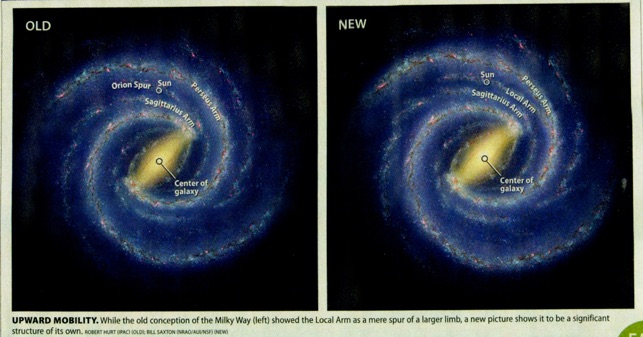

For more on the Spitzer telescope, please see:
http://www.spitzer.caltech.edu
&
http://en.wikipedia.org/wiki/Spitzer_Space_Telescope


Merit Badge Requirement
-
5.Do the following:
(a) List the names of the five most visible planets. Explain which ones can appear in phases similar to lunar phases and which ones cannot, and explain why.
(b) Using the internet (with your parents permission), and other resources, find out when each of the five most visible planets that you identified in requirement 5a will be observable in the evening sky during the next 12 months, then compile this information in the form of a chart or table.
(c) Describe the motion of the planets across the sky.
(d) Observe a planet and describe what you saw.
Your Merit Badge book has a information about the planets on pp 26-35.

5. Do the following:
a. List the names of the five most visible planets. Explain which ones can appear in phases similar to lunar phases and which ones cannot, and explain why.
The planets we can see with our naked eye are:
-
1.Mercury
-
2.Venus
-
3.Mars
-
4.Jupiter
-
5.Saturn
Your Merit Badge book has a information about planetary phases on pp 32-33.
In order to have phases, the planets’ sunlit areas need to be visible from Earth at different times.
Planets that are father from the sun than the Earth is from the sun will always show us their fully-lit faces.
Planets closer to the sun than the Earth is to the sun will demonstrate phases.
So to answer this requirement you will need to know which planets are closer to the sun or farther from the sun, than the earth is.

5. Do the following:
-
b.Using the Internet (with your parent’s permission) and other resources, find out when each of the five most visible planets that you identified in requirement 5a will be observable in the evening sky during the next 12 months, then compile this information in the form of a chart or table.
Dr. Wilking at UMSL has shared his page with us in recent STEM Universities, to help us see when the planets will be visible - http://www.nakedeyeplanets.com/visibility.htm.

image source: http://www.nakedeyeplanets.com/visibility.htm#2020

5. Do the following:
c. Describe the motion of the planets across the sky.
Your Merit Badge book has a information about planetary motion on pp 30-31.
To describe what you see, you could share:
-
-do they move east to west or west to east?
-
-do they change direction over time? if so, why? (“retrograde motion” can be better understood via this page: https://earthsky.org/space/what-is-retrograde-motion)
See more about planetary motion at: http://vanvooren.us/MeritBadges/Astronomy_-_Planetary_Motion.html

5. Do the following:
d. Observe a planet and describe what you saw.
To complete this requirement, you can use binoculars or a telescope, or just look at the planet(s) with your naked eye.
To describe what you see, you could share:
-
-when you observed (time of night, number of nights)
-
-where you observed... where you were (likely at home)
-
-where you looked in sky... direction, how high up in the sky
-
-what you saw... brightness compares to other planets and to the stars; color, possibly phases (unlikely with naked eye... you’d need help to see Mercury or Venus showing phases like the moon does)


Merit Badge Requirement
-
6.Do the following:
(a) Sketch the face of the Moon and indicate at least five sea and five craters. Label these landmarks.
(b) Sketch the phase and position of the Moon, at the same hour and place, for four nights, within a one-week period. Include landmarks on the horizon such as hills, trees and buildings. explain the changes you observe.
(c) List the factors that keep the Moon in orbit around Earth.
(d) With the aid of diagrams, explain the relative positions of the Sun, Earth and the Moon at the times of lunar and solar eclipses, and the times of new, first-quarter, full, and last-quarter phases of the Moon.
Your Merit Badge book has a information about the Moon on pp 38-45.

6. Do the following:
-
a.Sketch the face of the Moon and indicate at least five seas and five craters. Label these landmarks.
Your Merit Badge book has a information about lunar seas and craters on pp 40-41.

6. Do the following:
-
b.Sketch the phase and position of the Moon, at the same hour and place, for four nights, within a one-week period. Include landmarks on the horizon such as hills, trees and buildings. explain the changes you observe.
To complete this requirement, just look at the Moon with your naked eye.
To describe what you see, you could share:
-
-when you observed (time of night, number of nights)
-
-where you observed... where you were (likely at home)
-
-where you looked in sky... direction, how high up in the sky
-
-what you saw... which way did the Moon move (east to west or west to east? Higher to the right or lower to the left, etc.)
-
-Did the amount of the Moon that was lit increase or decrease night-over-night?

6. Do the following:
-
c.List the factors that keep the Moon in orbit around Earth.
Your Merit Badge book has a information about the Moon’s orbit on page 43.

6. Do the following:
-
d.With the aid of diagrams, explain the relative positions of the Sun, Earth and the Moon at the times of lunar and solar eclipses, and the times of new, first-quarter, full, and last-quarter phases of the Moon.
Your Merit Badge book has a information about eclipses on pp 41-45.
Additional diagrams showing the positions of the Sun, Earth and Moon during eclipses can be seen on:
http://vanvooren.us/MeritBadges/Astronomy_-_Solar_Eclipses.html
One of many sources of lunar phase information is:
http://www.timeanddate.com/calendar/moonphases.html
From the October, 2014 issue of Astronomy Magazine:
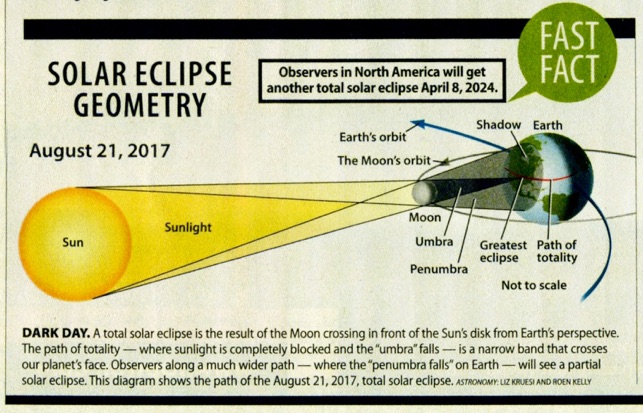


Merit Badge Requirement
-
7.Do the following:
(a) Describe the composition of the Sun, its relationship to other stars, and some effects of its radiation on Earth’s weather and communications.
(b) Define sunspots and describe some of the effects they may have on solar radiation.
(c) Identify at least one red star, one blue star, and one yellow star (other than the Sun). Explain the meaning of these colors.

7. Do the following:
-
a.Describe the composition of the Sun, its relationship to other stars, and some effects of its radiation on Earth’s weather and communications.
Your Merit Badge book has a information about the Sun’s composition on page 47, relationship to other stars on pp 52-53, and effects on Earth’s weather on p. 50.
This section provides some additional information about or Sun.
Astronomy Magazine provides this view of the sun’s composition in their August, 2013 issue:
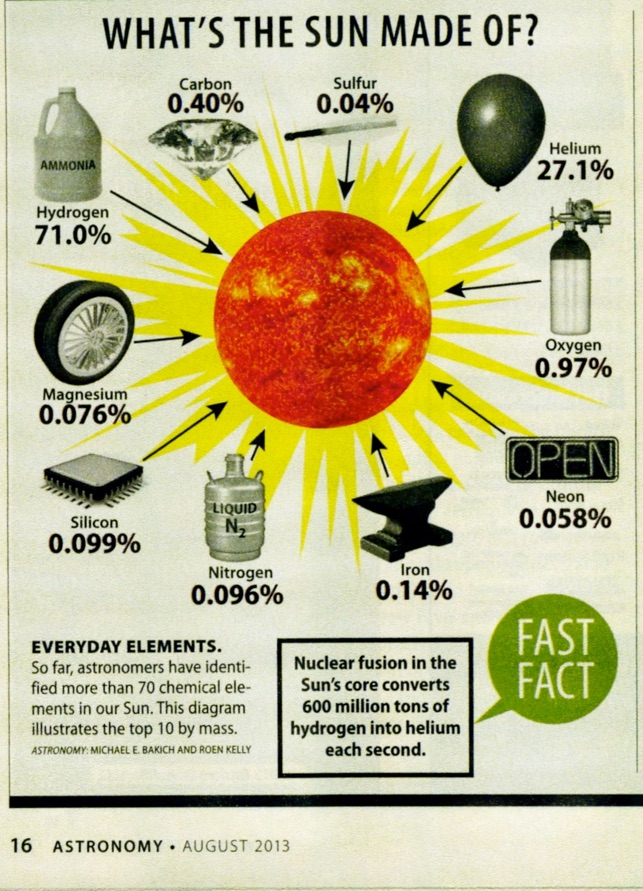
Not required for the answer, but a related interesting fact...
In the October, 2014 issue of Astronomy Magazine a reader asks ‘What would a bucketful of our sun contain?’ The answer, in the ‘Ask Astro’ section, starts with “It depends on how far down the well you drop the bucket. If you scoop from the Sun’s light-emitting surface, called the protosphere, you’ll get a gas considerably thinner than air is at sea level [on Earth]. Father down, the solar layers have to support the weight of the gasses above them, so the pressure increases. “ The gas composition also changes, as shown in this supporting graphic:
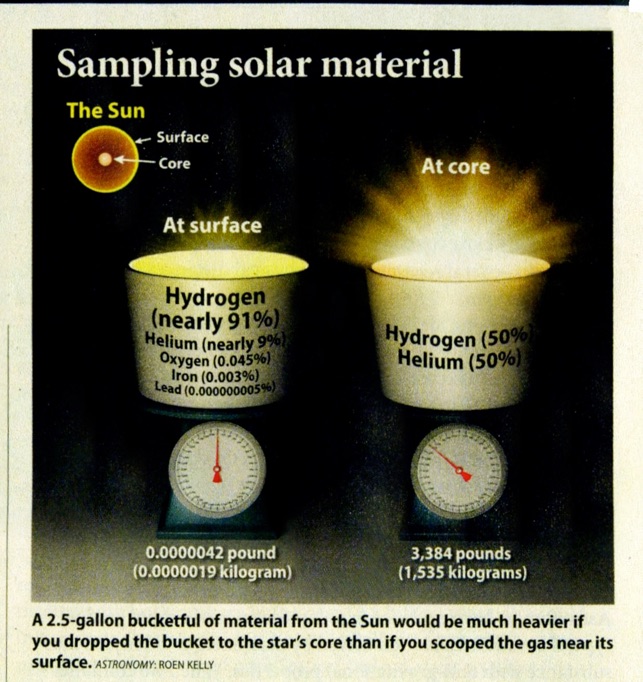
With respect to our Sun and its relationship to other stars...
Our sun is a yellow star, in the main sequence... that could be described as “medium size, medium brightness, medium heat output” compared to other stars.
Several efforts over the years categorized stars. You can learn more about these stellar classifications at: https://en.wikipedia.org/wiki/Stellar_classification.
The Hertzprung-Russell diagram shows the “relationship between the stars' absolute magnitudes or luminosities versus their stellar classifications or effective temperatures. More simply, it plots a star's luminosity (brightness) against its temperature (color).
The diagram was created circa 1910 by Ejnar Hertzsprung and Henry Norris Russell and represents a major step towards an understanding of stellar evolution.
The related color–magnitude diagram (CMD) plots the apparent magnitudes of stars against their color, usually for a cluster so that the stars are all at the same distance.”
source: https://en.wikipedia.org/wiki/Hertzsprung-Russell_diagram
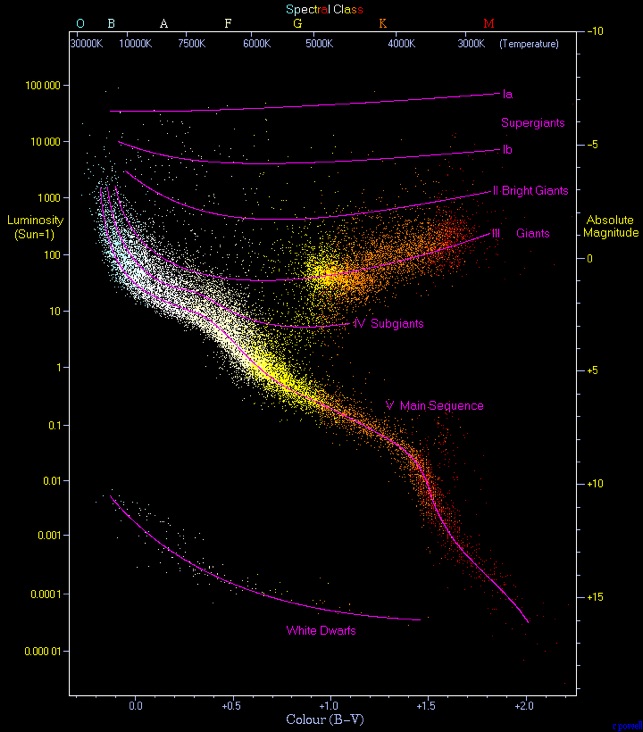
“An observational Hertzsprung–Russell diagram with 22,000 stars plotted from the Hipparcos Catalogue and 1,000 from the Gliese Catalogue of nearby stars. Stars tend to fall only into certain regions of the diagram. The most prominent is the diagonal, going from the upper-left (hot and bright) to the lower-right (cooler and less bright), called the main sequence. In the lower-left is where white dwarfs are found, and above the main sequence are the subgiants, giants and supergiants. The Sun is found on the main sequence at luminosity 1 (absolute magnitude 4.8) and B−V color index 0.66 (temperature 5780 K, spectral type G2V).”
source: https://en.wikipedia.org/wiki/Hertzsprung-Russell_diagram

7. Do the following:
-
b.Define sunspots and describe some of the effects they may have on solar radiation.
Your Merit Badge book has a information about sunspots on pp 48-49.
This section provides some additional information about or Sun.
With respect to solar radiation impacting communications, NASA shares this:
“The explosive heat of a solar flare can't make it all the way to our globe, but electromagnetic radiation and energetic particles certainly can. Solar flares can temporarily alter the upper atmosphere creating disruptions with signal transmission from, say, a GPS satellite to Earth causing it to be off by many yards. Another phenomenon produced by the sun could be even more disruptive. Known as a coronal mass ejection or CME these solar explosions propel bursts of particles and electromagnetic fluctuations into Earth's atmosphere. Those fluctuations could induce electric fluctuations at ground level that could blow out transformers in power grids. A CME's particles can also collide with crucial electronics onboard a satellite and disrupt its systems.
“In an increasingly technological world, where almost everyone relies on cellphones, and GPS controls not just your in-car map system, but also airplane navigation and the extremely accurate clocks that govern financial transactions, space weather is a serious matter.
“But it is a problem the same way hurricanes are a problem. One can protect oneself with advance information and proper precautions. During a hurricane watch, a homeowner can stay put … or he can seal up the house, turn off the electronics and get out of the way. Similarly, scientists at NASA and NOAA give warnings to electric companies, spacecraft operators and airline pilots before a CME comes to Earth so that these groups can take proper precautions.
“NOAA's Space Weather Prediction Center (http://swpc.noaa.gov) is the U.S. government's official source for space weather forecasts, alerts, watches and warnings. Improving these predictive abilities the same way weather prediction has improved over the last few decades is one of the reasons NASA studies the sun and space weather. We can't ignore space weather, but we can take appropriate measures to protect ourselves.
“And, even at their worst, the sun's flares are not physically capable of destroying Earth.“
source: https://www.nasa.gov/mission_pages/sunearth/news/flare-impacts.html

7. Do the following:
-
c.Identify at least one red star, one blue star, and one yellow star (other than the Sun). Explain the meaning of these colors.
Your Merit Badge book has a information about star types on page 52.


Merit Badge Requirement
-
8.With your counselor’s approval and guidance, do ONE of the following:
(a) Visit a planetarium or astronomical observatory. Submit a written report, a scrapbook, or a video presentation afterward to your counselor that includes the following information:
(1) Activities occurring there
(2) Exhibits and displays you saw
(3) Telescopes and other instruments being used
(4) Celestial objects you observed
(b) Plan and participate in a three-hour observation session that includes using binoculars or a telescope. List the celestial objects you want to observe, and find each on a star chart or in a guidebook. Prepare a log or notebook. Discuss with your counselor what you hope to observe prior to your observation session. Review your log or notebook with your counselor afterward.
(c) Plan and host a star party for your Scout troop or other group such as your class at School. Use binoculars or a telescope to show and explain celestial objects to the group.
(d) Help an astronomy club in your community hold a star party that is open to the public.
(e) Personally take a series of photographs or digital images of the movement of the Moon, a planet, an asteroid, meteor, or a comet. In your visual display, label each image and include the date and time it was taken. Show all positions on a star chart or map. Show your display at school or at a troop meeting. Explain the changes you observed.
For STEM University, we will complete Requirement 8a at the UMSL Planetarium, thanks to Dr. Bruce Wilking and the UM-St. Louis Physics & Astronomy Department.


Merit Badge Requirement
-
9.Find out about three career opportunities in astronomy. Pick one and find out the education, training, and experience required for this profession. Discuss this with your counselor, and explain why this profession might interest you.



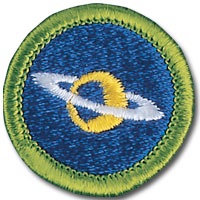
These are all of the links to the Astronomy Merit Badge pages:
Astronomy Merit Badge - Extra “Fun Facts”
Astronomy - Great American Eclipse
Astronomy - Great American Eclipse 2017

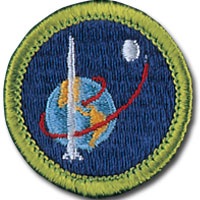
These are all of the links to the Space Exploration Merit Badge pages:
New Horizons - Mission Overview
New Horizons - Pluto Resources


The images from Mr. Berman’s “Secrets of the Night Sky...” and Outdoor Photographer were scanned directly from the book using the Halo Scanner Mouse - http://shop.halo2cloud.com/collections/computer-and-backup/products/scanner-mouse, which I received as a Christmas present from my mother in 2013.



Regardless your desire to pursue an astronomical career, it is hoped that you learned enough about astronomy through this merit badge to at least be interested to continuously look up at the sky in awe and wonder. If you pursue with enthusiastic interest, that’s great. If you do make a career in the field, GREAT.
May you be better off having completed your Astronomy Merit Badge than you were before you started.
